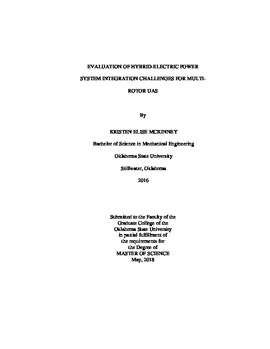| dc.contributor.advisor | Jacob, Jamey Darin | |
| dc.contributor.author | McKinney, Kristen Elise | |
| dc.date.accessioned | 2019-03-29T15:39:54Z | |
| dc.date.available | 2019-03-29T15:39:54Z | |
| dc.date.issued | 2018-05-01 | |
| dc.identifier.uri | https://hdl.handle.net/11244/317806 | |
| dc.description.abstract | The modern standard for multi-rotor unmanned aircraft system (UAS) propulsion is an electric configuration typically consisting of battery-powered electric motors. The primary issue with this type of propulsion system is the low energy density of the battery, which results in shorter flight times or lower payload capacity than typically desired. One possible solution for this is implementation of a hybrid-electric power system, which has been demonstrated to improve endurance in both fixed and rotary wing aircraft. The purpose of this study is to investigate the integration challenges of implementing a hybrid-electric power system on multi-rotor UAS, specifically one that utilizes a gasoline internal combustion engine. While design of a fully-integrated hybrid-electric power system is not within the scope of this study, rather experiments are conducted with intentions to provide crucial insights to expedite the design and implementation process. Integration challenges such as vibration, cooling requirements, and additional noise of small combustion engines are investigated. It is shown that a small combustion engine can produce forceful vibration signatures, the affects of which must be considered when designing a hybrid-electric power system. Without proper dampening, this additional vibration has been shown to negatively impact the function of the on-board sensors necessary for controlling small UAS (sUAS). It has also been shown that forced convection, or other external cooling, is a requirement for the small combustion engine used for this study, which presents a unique challenge in hover-capable aircraft that don't inherently supply active airflow. However, the cooling requirements of these types of engines can be estimated when designing a hybrid-electric power system, and weight-efficient solutions can be found. Finally, it has been shown that a small, two-stroke combustion engine would have a significant contribution to the overall noise signature of a hybrid-electric sUAS. Through a computational method of isolating and combining individual noise sources, the theoretical acoustic signature of a multi-rotor sUAS with a hybrid-electric power system was produced. The conclusion of this study confirms that each of the initially identified major integration challenges (vibration, cooling, and noise) must be considered when designing a hybrid-electric power system for multi-rotor sUAS, and also provides insights into how each challenge could be addressed. | |
| dc.format | application/pdf | |
| dc.language | en_US | |
| dc.rights | Copyright is held by the author who has granted the Oklahoma State University Library the non-exclusive right to share this material in its institutional repository. Contact Digital Library Services at lib-dls@okstate.edu or 405-744-9161 for the permission policy on the use, reproduction or distribution of this material. | |
| dc.title | Evaluation of Hybrid-Electric Power System Integration Challenges for Multi-Rotor UAS | |
| dc.contributor.committeeMember | Gaeta, Richard Joseph | |
| dc.contributor.committeeMember | Rouser, Kurt P. | |
| dc.contributor.committeeMember | Kidd, James Allan | |
| osu.filename | McKinney_okstate_0664M_15755.pdf | |
| osu.accesstype | Open Access | |
| dc.description.department | Mechanical and Aerospace Engineering | |
| dc.type.genre | Thesis | |
| dc.type.material | text | |
